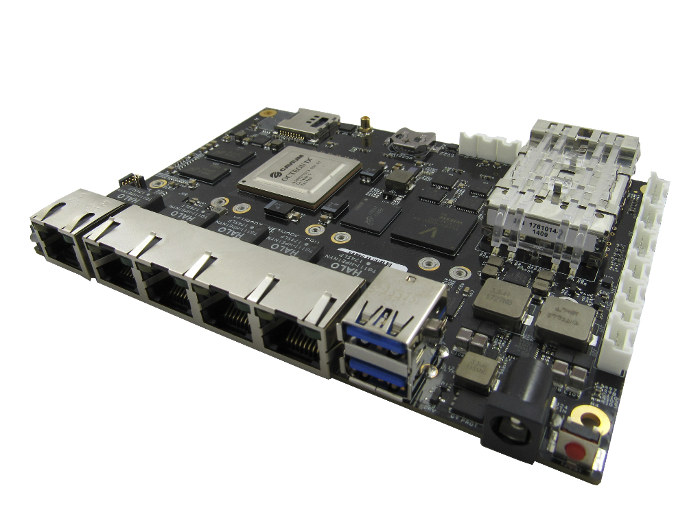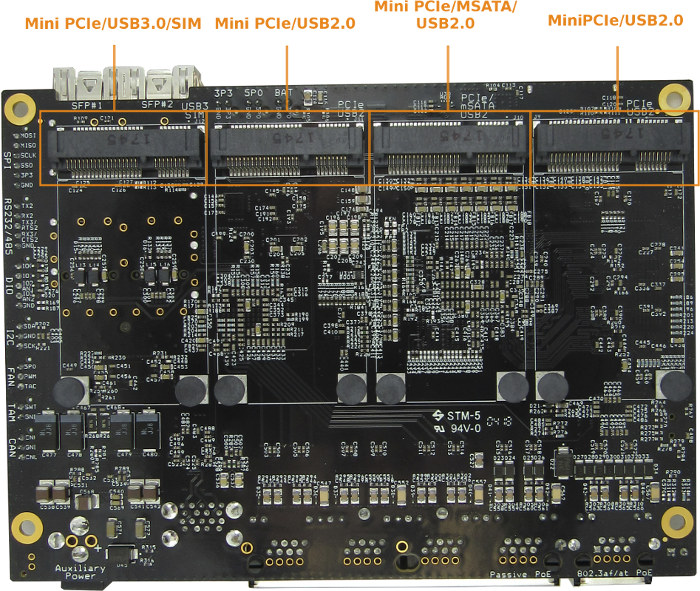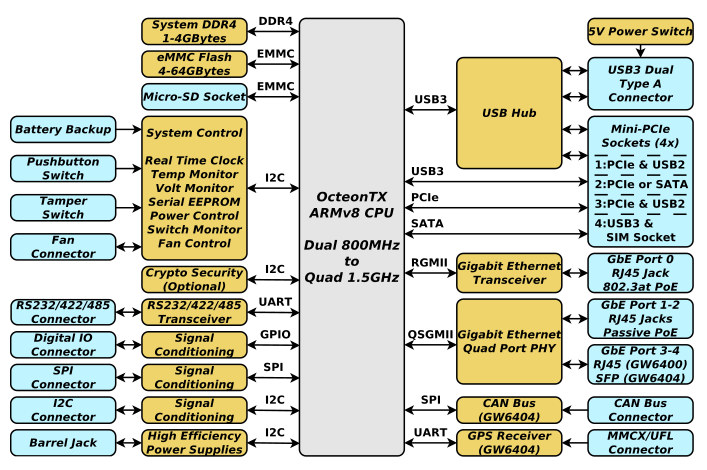Gateworks introduced their Newport SBC family based on Cavium Octeon TX Dual/Quad Core Arm processors at the end of last year, and the company has now announced the availability of the higher end models of their networking single board computers with Newport GW6400 & GW6404, which provide four mPCIe sockets for expansion, five Gigabit Ethernet ports, and in the case of GW6404, two optional SFP cages for fiber connections.

GW6400 / GW6404 specifications:
- SoC
- GW6400 – Cavium OcteonTX CN8120 dual core processor up to 800MHz
- GW6404 – Cavium OcteonTX CN8130 quad core processor up to 1.5 GHz
- System Memory
- GW6400 – 1 GB DDR4 DRAM
- GW6404 – 2 GB DDR4 DRAM
- Storage – 8 GB eMMC Flash , micro SD card slot, serial configuration EEPROM
- Connectivity
- 5x GbE Ethernet ports
- GW6404 – Up to 2x optional SFP fiber ports (redirect of one or two of the RJ45 ports to SFP connectors)
- USB – 2x USB 3.0 ports up to 5Gbps SuperSpeed
- GW6404 specific features (and optional in GW6400)
- Ublox ZOE-MQ8 GNSS GPS Receiver with PPS
- Microchip MCP25625 2.0B CAN Bus Controller
- Expansion
- 4x Mini-PCIe sockets
- Socket 1: PCIe or GW1608x Expansion, USB 2.0
- Socket 2: PCIe or mSATA
- Socket 3: PCIe, USB 2.0
- Socket 4: USB 2.0/3.0, SIM Socket
- Digital I/O, SPI, and I2C expansion headers
- 2x RS232 or 1x RS232/422/485 serial headers
- 4x Mini-PCIe sockets
- HW Security – Optional Maxim DS28C22 Secure Authentication and Encryption, tamper switch support
- Misc – RTC with Battery Backup, voltage and temperature monitor, programmable watchdog timer, fan speed controller, programmable shut-down and wake-up
- Power Supply
- 8 to 60V via power barrel jack
- Ethernet Jack Passive PoE Input Voltage Range 10 to 60V
- Ethernet Jack 802.3at PoE Input Voltage Range 37 to 57V
- Input Voltage Reverse and Transient Protection
- Power Consumption (typ.) – GW6400: 6W @ 25°C; GW6404: 7W @ 25°C
- Dimensions – 140 x 100 mm (compatible with GW5400 Ventana Media SBC)
- Temperature Range – -40°C to +85°C

System memory can be customized up to 4GB RAM, and internal storage up to 64GB eMMC flash. The company provides both OpenWrt and Ubuntu BSPs for the boards, as well as u-boot source code, and Gateworks System Controller MCU firmware code that handle RTC, voltage & temperature monitor, fan speed control, and so on. You’ll find documentation in the dedicated Wiki.
GW6400 / GW6404 development kits include the corresponding network SBC, Ethernet, Serial, and USB cables, passive PoE power injector and power supply, as well as a JTAG programmer.
 The boards and development kits are available now at an undisclosed price. For more details, the datasheet and user manual can be downloaded via product page.
The boards and development kits are available now at an undisclosed price. For more details, the datasheet and user manual can be downloaded via product page.

Jean-Luc started CNX Software in 2010 as a part-time endeavor, before quitting his job as a software engineering manager, and starting to write daily news, and reviews full time later in 2011.
Support CNX Software! Donate via cryptocurrencies, become a Patron on Patreon, or purchase goods on Amazon or Aliexpress





Could be cool for some network appliances, but as usual with Cavium, there appears to be zero mainline support for these SoCs, and it’s likely that it’s more expensive than an Atom-based equivalent board which would be perfectly supported and well documented.
At least there is a 4.14.4 that seems to be based on mainline from back then? https://github.com/Gateworks/linux-newport
Oh indeed, and there doesn’t seem to be that many patches there, mostly fixes, so there are hopes that it could be usable as-is. And it’s nice to see they did this work on top of the latest LTS branch by the way.
Speaking of more rare arm chips, things could be shrinking in choice
Qualcomm reported to be dumping Arm-based server chips
Unrelated to the topic at hand. And don’t expect Qualcomm’s server chips to just vanish — qcomm will want to sell the division.
OK so how many 3.5″ HDDs could we hang off those PCIe ports?
3 mPCIe slots with PCIe exposed (single lane). In each slot you can put a Marvell 88SE9215 mPCIe card (using PCIe Gen2 x1) to provide 4 SATA ports. Now you have 12 SATA ports in total where you can either connect a disk to or a (Marvell) SATA port multiplier. This way you can attach 60 or even more 3.5″ HDDs to this board which would be the slowest bunch of disks we’ve seen so far 😉
As soon as you think about available bandwidth, PSU dimensions and the requirement for some sort of an enclosure the idea to attach many 3.5″ disks to this board doesn’t look that wise.